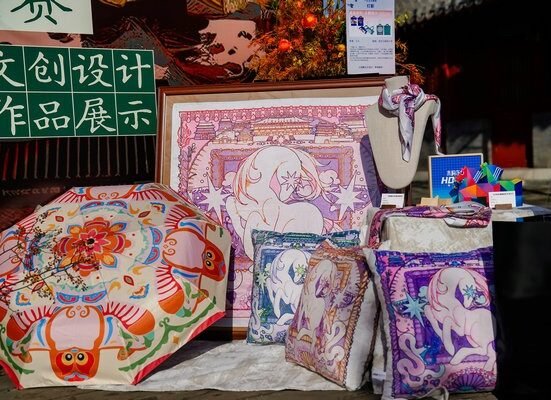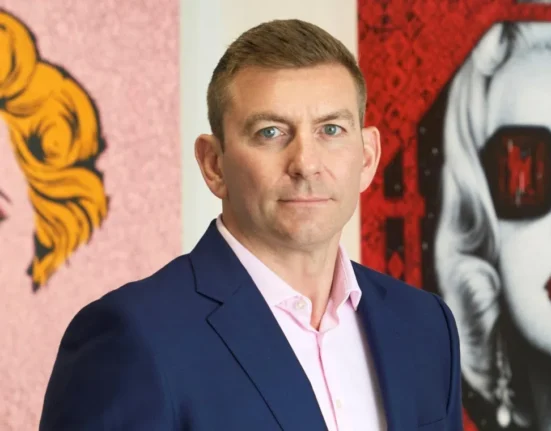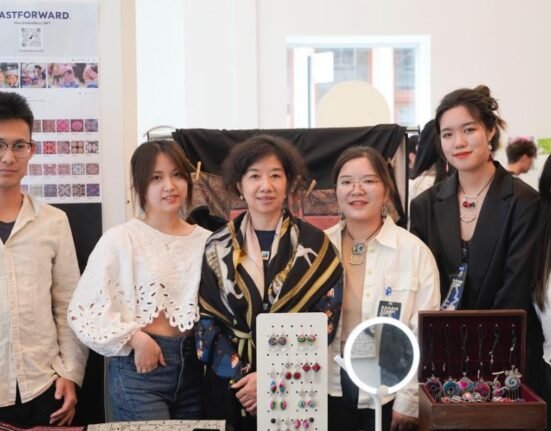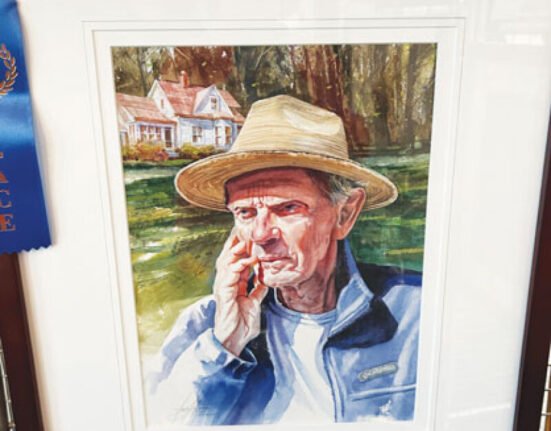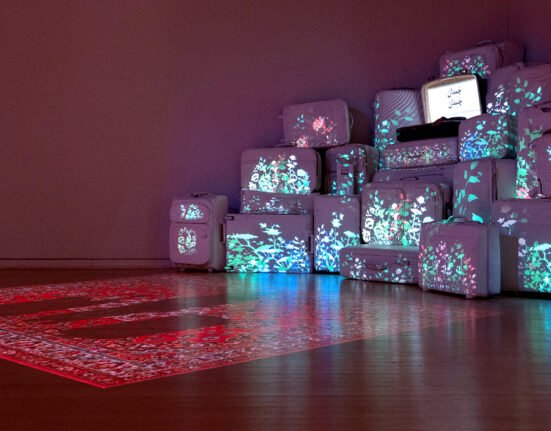In a year marked by global uncertainty and local transformation, this year’s Mackintosh School of Architecture degree show emerges as a quiet triumph. More than a showcase of final year work, it serves as a testament to the school’s continual perseverance, creative vitality and collective spirit, especially poignant given its proximity to the fire-damaged Mackintosh building.
That building, once a cornerstone of national architectural heritage, now stands as a painful scar inscribed into the fabric of the Glasgow School of Art (GSA) campus. Its silent anti-presence is in stark contrast to the energy of the adjacent Bourdon Building on the architecture degree show’s opening night.

Postgraduate student Hayley Peel’s It Takes a Village
From the outset, the exhibition feels grounded, tactile and intentional. The student work embraces themes of social justice, environmental urgency and community-led design. The physical models on display are exquisitely detailed, and drawings reveal a level of precision, analogue artistry and thoughtfulness. Housing is reimagined as a platform for care, landscapes are rewilded with sensitivity, and derelict infrastructures are transformed into cultural commons.
Among the many highlights is Dear Green Place by Rhemshah Sajid, a timber-led urban intervention for Glasgow Wood, which reclaims oversaturated car infrastructure in favour of community-focused green spaces. Urban Filament by James Henry Telfer is a slender, modular housing proposal in Tradeston that addresses the city’s fractured urban fabric with careful attention to thresholds, dignity and collective living. It Takes a Village by Hayley Peel is a fertility hub that translates the journey from womb to world into a spatial form while reimagining care architecture with tactile, embodied sensitivity. And there’s Tom Matthews’ Énergie en Friche (see top image), which explores the reappropriation and restoration of the post-industrial landscape and the visibility of power in civic consciousness.

Undergraduate student Rhemshah Sajid’s Dear Green Place
These projects don’t feel like utopian dreams, but rather plausible futures, and are sensitive and intelligent responses to complex real-world issues.
Rather than prioritising spectacle, the show embraces strategies that are adaptive, generous and often temporary. Architectural language throughout is less about permanence and grandeur, more about a dialogue we may all long for – a visual conversation with users, with sites and with changing climates. It seems that what this cohort of students presents is not a fixed architectural vision but a set of possibilities; ideas that are open-ended, responsive and deeply human. There is a quiet optimism that threads through the themes and visual language of the entire show; an insistence that buildings can be softer and less prescriptive, cities fairer and futures more inclusive.

Urban Filament – Housing Proposal in Tradeston by James Henry Telfer, undergraduate student
This culture of critical making reflects the influence of the school’s wider ecosystem. The strength of the Mackintosh lies not solely in its curriculum, but in the community that shapes it. The cohort of tutors and lecturers brings energy well beyond the classroom, evidenced by initiatives such as the now well-established Missing in Architecture, a platform advocating for equity and expanded narratives in design; and Andy Summers and Dom Hogston’s Architecture Fringe festival, which continues to shape architectural discourse across Glasgow and Scotland.

Undergraduate student Tom Matthews’ Énergie en Friche
What isn’t always visible in an end-of-year degree show is the depth of process that underpins the work. The conversations, diversions and experiments often shape the students’ development more than we can see in the final pin-ups. One such example is Johnny Rodger’s Housing and Film elective, which pushes students to engage with architectural ideas through less conventional means, from housing policy to filmmaking and critical writing. It uses art as a catalyst where the emphasis shifts from resolution to exploration, and where architecture becomes as much about thinking and storytelling as it is about drawing and building.
In many ways, this show feels like a reassertion of identity, not in defiance of global and immediate adversity but because of it. The scars left by the Mac’s fire are real, and the echoes of the pandemic still linger, but the work on display does not dwell in crisis. Instead, it ruminates on questions such as ‘what makes an ethical city?’ and pushes forward, carrying with it the belief that architecture is most powerful when it listens, adapts and responds with empathy and care.

Crawley – Beyond the Moongate by Joseph Michael Collins, undergraduate student
In our context of uncertainty – whether that be environmental, economic or political – the Mackintosh School has offered something steady, intimate and ambitious. This year’s degree sshow reminds us that architecture is not simply about constructing aesthetically pleasing and grand spaces, but rather about empathy, ethics and the reimagining of how we might meaningfully co-exist in our cities.
Veronika Desova is a Bulgarian and Scottish multidisciplinary artist, architect and educator based between Glasgow, New York and Sofia

Mackintosh School of Architecture degree show 2025 (credit: Alan McAteer)


